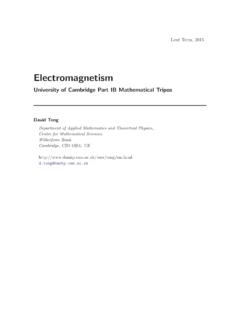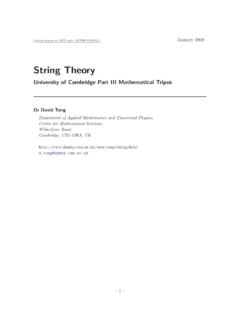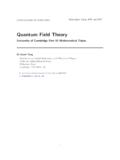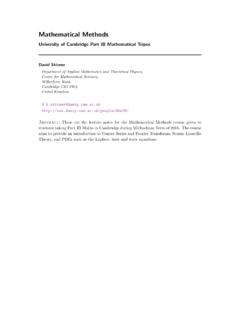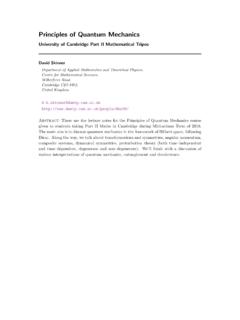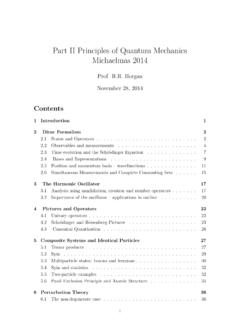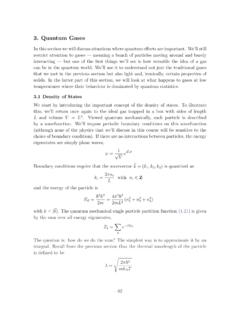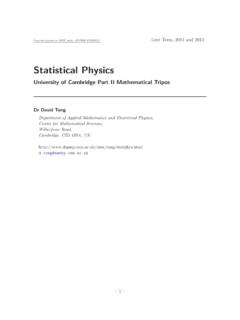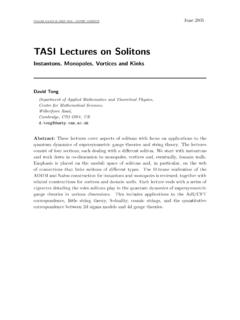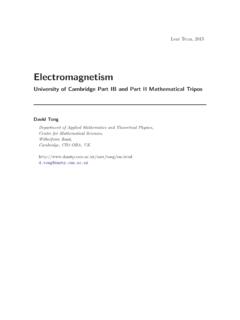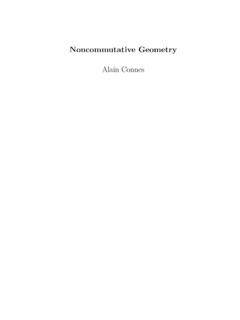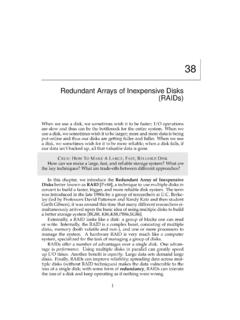Transcription of The Quantum Hall E ect - University of Cambridge
1 Preprint typeset in JHEP style - HYPER VERSIONJ anuary 2016 The Quantum hall EffectTIFR Infosys LecturesDavid TongDepartment of Applied Mathematics and Theoretical Physics,Centre for Mathematical Sciences,Wilberforce Road, Cambridge , CB3 OBA, 1 Recommended Books and ResourcesThere are surprisingly few dedicated books on the Quantum hall effect. Two prominentones are Prange and Girvin, The Quantum hall Effect This is a collection of articles by most of the main players circa 1990. The basics aredescribed well but there s nothing about Chern-Simons theories or the importance ofthe edge modes. J. K. Jain, Composite Fermions As the title suggests, this book focuses on the composite fermion approach as a lensthrough which to view all aspects of the Quantum hall effect.
2 It has many goodexplanations but doesn t cover the more field theoretic aspects of the are also a number of good multi-purpose condensed matter textbooks whichcontain extensive descriptions of the Quantum hall effect. Two, in particular, standout: Eduardo Fradkin,Field Theories of Condensed Matter Physics Xiao-Gang Wen, Quantum Field Theory of Many-Body Systems: From the Originof Sound to an Origin of Light and ElectronsSeveral excellent lecture notes covering the various topics discussed in these lec-tures are available on the can be found on the course webpage: The Classical hall Motion in a Magnetic Drude hall Quantum hall Quantum hall on an Electric Berry Phase and Berry Example: A Spin in a Magnetic Moving Around a Flux Berry Connection382.
3 The Integer Quantum hall in Filled Landau of the hall Role of Role of Gauge Aside: The Kubo Role of on a Chern on a Lattice in a Magnetic Field67 1 3. The Fractional Quantum hall Laughlin and to Detect an State Degeneracy and Topological Filling Half-Filled Landau for Particles with Spin1134. Non-Abelian Quantum hall in Higher Landau Moore-Read Zero Theory of Non-Abelian Fusion is a Subject Called Topological Quantum Computing1455. Chern-Simons Integer Quantum hall Chern-Simons Aside: Periodic Time Makes Things of the Chern-Simons Fractional Quantum hall First Look at Chern-Simons Effective Theory for the Laughlin Theory on a Torus164 2 Filling Fractions and the Abelian-Higgs and the Chern-Simons Ginzburg-Landau Fermions and the Half-Filled Landau Chern-Simons Non-Abelian Chern-Simons Quantisation and Topological Theory with Wilson Theories of Non-Abelian Quantum hall States2006.
4 Edge View from the View from Chern-Simons Chiral and Bulk-Boundary the Laughlin for Chern-Simons on the Free the Moore-Read Forwards: More Conformal Field Theory231 3 AcknowledgementsThese lectures were given in TIFR, Mumbai. I m grateful to the students, postdocs,faculty and director for their excellent questions and comments which helped me a lotin understanding what I was first approximation, these lecture notes contain no references to original work. I veincluded some footnotes with pointers to review articles and a handful of key extensive references can be found in the review articles mentioned earlier, or inthe book of reprints, Quantum hall Effect , edited by Michael thanks to everyone in TIFR for their warm hospitality.
5 Thanks also to BartAndrews for comments and typo-spotting and to Steve Kivelson for a number of illumi-nating comments. These lecture notes were written as preparation for research fundedby the European Research Council under the European Union s Seventh FrameworkProgramme (FP7/2007-2013), ERC grant agreement STG 279943, Strongly CoupledSystems .Magnetic ScalesCyclotron Frequency: B=eBmMagnetic Length:lB=r eBQuantum of Flux: 0=2 eHall Resistivity: xy=2 e21 4 1. The IntroductionTake a bunch of electrons, restrict them to move in a two-dimensional plane and turnon a strong magnetic field. This simple set-up provides the setting for some of the mostwonderful and surprising results in physics.
6 These phenomena are known collectivelyas thequantum hall name comes from the most experimentally visible of these surprises. The Hallconductivity (which we will define below) takes quantised values xy=e22 Originally it was found that is, to extraordinary precision, integer valued. Of course,we re very used to things being quantised at the microscopic, atomic level. But thisis something different: it s the quantisation of an emergent, macroscopic property ina dirty system involving many many particles and its explanation requires somethingnew. It turns out that this something new is the role that topology can play in quantummany-body systems. Indeed, ideas of topology and geometry will be a constant themethroughout these , it was found that is not only restricted to take integer values, but canalso take very specific rational values.
7 The most prominent fractions experimentallyare = 1/3 and = 2/5 but there are many dozens of different fractions that havebeen seen. This needs yet another ingredient. This time, it is the interactions betweenelectrons which result in a highly correlated Quantum state that is now recognised as anew state of matter. It is here that the most remarkable things happen. The chargedparticles that roam around these systems carry a fraction of the charge of the electron,as if the electron has split itself into several pieces. Yet this occurs despite the factthat the electron is (and remains!) an indivisible constituent of fact, it is not just the charge of the electron that fractionalises: this happens to the statistics of the electron as well.
8 Recall that the electron is a fermion, which meansthat the distribution of many electrons is governed by the Fermi-Dirac distributionfunction. When the electron splits, so too does its fermionic nature. The individualconstituents are no longer fermions, but neither are they bosons. Instead they are newentities known asanyonswhich, in the simplest cases, lie somewhere between bosonsand fermions. In more complicated examples even this description breaks down: theresulting objects are callednon-Abelian anyonsand provide physical embodiment ofthe kind of non-local entanglement famous in Quantum mechanics. 5 Because of this kind of striking behaviour, the Quantum hall effect has been a con-stant source of new ideas, providing hints of where to look for interesting and novelphenomena, most of them related to the ways in which the mathematics of topologyimpinges on Quantum physics.
9 Important examples include the subject of topologicalinsulators, topological order and topological Quantum computing. All of them havetheir genesis in the Quantum hall all of these phenomena is an impressive theoretical edifice, which involvesa tour through some of the most beautiful and important developments in theoreticaland mathematical physics over the past decades. The first attack on the problem fo-cussed on the microscopic details of the electron wavefunctions. Subsequent approacheslooked at the system from a more coarse-grained, field-theoretic perspective where asubtle construction known as Chern-Simons theory plays the key role.
10 Yet anotherperspective comes from the edge of the sample where certain excitations live that knowmore about what s happening inside than you might think. The main purpose of theselectures is to describe these different approaches and the intricate and surprising linksbetween The Classical hall EffectThe original, classical hall effect was discovered in 1879 by Edwin hall . It is a simpleconsequence of the motion of charged particles in a magnetic field. We ll start theselectures by reviewing the underlying physics of the hall effect. This will provide auseful background for our discussion of the Quantum hall s the set-up. We turn on a constant mag-xIHVBF igure 1:The classical hall ef-fectnetic field,Bpointing in thez-direction.
